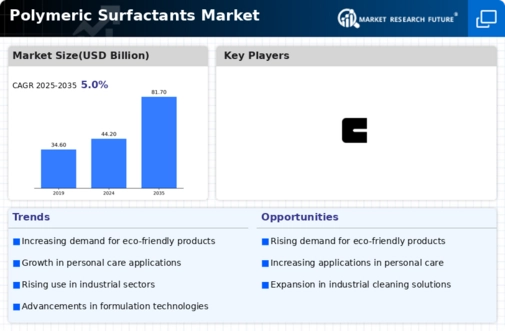Top Industry Leaders in the Polymeric Surfactants Market
 The polymeric surfactants market is a dynamic and evolving space witnessing intense competition among established players and innovative newcomers. This report dives into the key strategies adopted by major players, factors influencing market share, industry news, and recent developments shaping the landscape over the past six months.
The polymeric surfactants market is a dynamic and evolving space witnessing intense competition among established players and innovative newcomers. This report dives into the key strategies adopted by major players, factors influencing market share, industry news, and recent developments shaping the landscape over the past six months.
Competitive Strategies:
Product Diversification: Leading players like Solvay, BASF, and Dow Chemical are expanding their portfolios to cater to diverse industry needs. Solvay recently introduced a new line of amphoteric polymeric surfactants for personal care applications, while BASF launched a range of high-performance block copolymers for oil and gas exploration.
Sustainability Focus: Growing environmental awareness is driving the development of bio-based and readily biodegradable polymeric surfactants. Companies like Stepan Company and Evonik Industries are investing heavily in R&D to create sustainable alternatives to traditional petroleum-based surfactants.
Regional Expansion: Asia-Pacific, particularly China and India, is emerging as a key growth market for polymeric surfactants. Companies are establishing production facilities and forging partnerships in these regions to tap into the burgeoning demand.
Technological Advancements: Continuous innovations in synthesis and polymerization techniques are leading to the development of novel polymeric surfactants with superior performance characteristics. For example, Clariant recently introduced a new class of comb-shaped surfactants with improved wetting and thickening properties.
Mergers and Acquisitions: Consolidation is a significant trend in the market, with established players acquiring smaller companies with specialized technologies or regional expertise. In July 2023, Croda International acquired the surfactant business of Solvay, further solidifying its position in the market.
Factors Influencing Market Share:
-
Product Innovation: Companies with a strong pipeline of new and differentiated polymeric surfactants are likely to gain market share. -
Sustainability Credentials: The ability to offer bio-based and biodegradable products will be a key differentiator in the coming years. -
Regional Presence: Strong presence in high-growth markets like Asia-Pacific will be crucial for long-term success. -
Cost Competitiveness: Efficient production processes and optimized supply chains will be essential for maintaining profitability. -
Brand Reputation: Companies with a strong reputation for quality and reliability will have a competitive advantage.
Key Players
- Kao Corporation
- BASF SE
- Croda International PLC
- Akzo Nobel NV
- Clariant
- Evonik Industries AG
- Huntsman International LLC
- DAI-ICHI
- Stepan Company
- Air Products and Chemicals, Inc
Recent Developments:
-
October 2023: BASF announced the expansion of its production capacity for polyethylene glycol (PEG) surfactants at its Ludwigshafen, Germany, site. -
November 2023: Stepan Company launched a new line of high-performance polyetheramine surfactants for industrial cleaning applications. -
December 2023: Evonik Industries signed a partnership agreement with a Chinese company to distribute its bio-based surfactants in the Asia-Pacific region. -
January 2024: Solvay announced the commercialization of a new bio-based acrylic acid surfactant for use in personal care formulations. -
February 2024: Dow Chemical filed a patent for a novel method for the synthesis of biodegradable polymeric surfactants.

